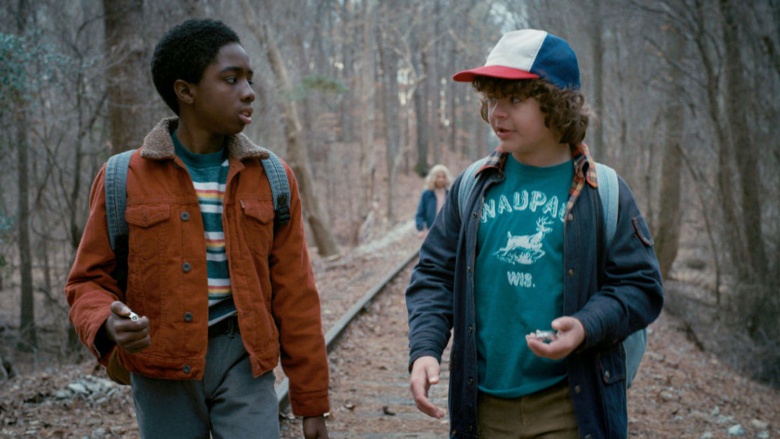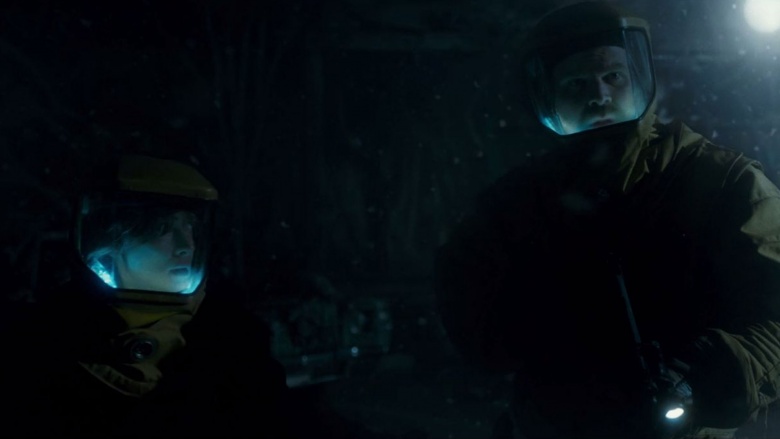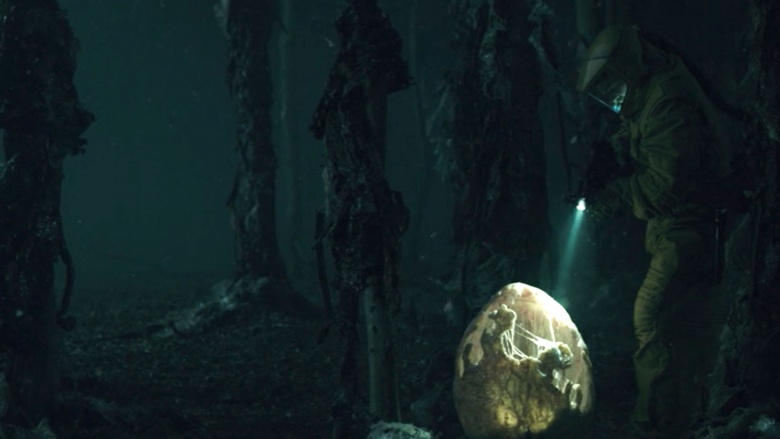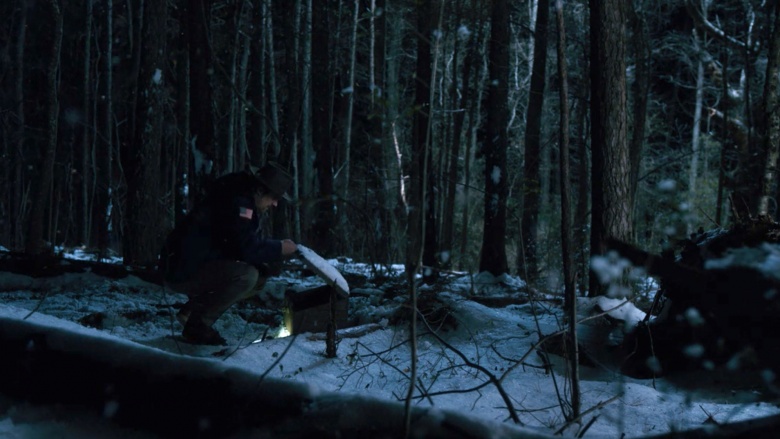What Is The Upside Down On Stranger Things?
On the Netflix sci-fi smash hit Stranger Things, viewers were treated to a wild ride of nostalgia, horror, and mystery set during 1983 in the fictional Hawkins, Indiana. The plot of Season 1 centered on the mysterious disappearance of young Will Byers, and the eerie events that follow. In this article, I'm going to take a look at one of the stranger elements of the plot — Upside Down — and attempt to explain the truth behind this paranormal phenomenon. But fair warning, below the cut, this article contains spoilers from Stranger Things Season 1.
What we know about the Upside Down
The Upside Down appears to be a reflection of the real world, with structures and even trees in approximately the same place as their 1983 counterparts. While the buildings and other structures in the Upside Down are analogues to the real world, they are dilapidated and in ruinous condition. It constantly appears to be dark in the Upside Down, no matter the time of day in the real world. Chunks of particulate dust are constantly falling and swirling through the air in the Upside Down, even while indoors. I think many people assumed at first that this was snow, as it does appear to be colder in the Upside Down than in the real world. However, there are several scenes that illustrate the dust is more gray than white and does not accumulate in significant quantities. Additionally, we know that the air itself in the Upside Down is toxic enough to kill a human with enough exposure to it. These are all significant clues to the true nature of this alternate world, which I'll explore in more detail shortly.
The Vale of Shadows
Mike and his friends make the assumption that the Upside Down is in another dimension, something they believe to be similar to the "Vale of Shadows." While there wasn't actually a "Vale of Shadows" in official D&D rule books, there was something called the Plane of Shadow, or the Shadowfell. From the 4th edition D&D Manual of the Planes, we learn that "The Shadowfell is the dark echo of the mortal world, a twilight realm that exists 'on the other side' of the world and its earthly denizens." This sounds very similar to what is read by the boys in the show — "The Vale of Shadows is a dimension that is a dark reflection, or echo, of our world. It is a place of decay and death, a plane out of phase, a [place] with monsters. It is right next to you and you don't even see it."
The flea and the acrobat
The show gives us some additional clues to consider. When asked where Will is at, Eleven responds by taking the D&D game board — representing the universe of the show — and flips it over. In the episode "The Flea and the Acrobat," the boys' science teacher gives us a basic explanation of extremely small extra dimensions, a founding principle of string theory and part of the exploration of particle physics, which is being researched by organizations like CERN. An acrobat on a tightrope can only observe a single dimension of travel — forward and backward. However a flea on that same tightrope can observe a second dimension, allowing it to travel forward and backward as well as side to side, moving around and even under the tightrope. Obviously, the Upside Down isn't extremely small like those dimensions theorized by string theory, but his analogy does neatly explain why a normal person would not be able to directly see or observe an alternate dimension like the Upside Down.
What's the deal with the gate?
Mr. Clarke gave the boys some interesting tidbits of info about what such a portal might be like. It could affect gravity and magnetism, and might even swallow us whole. The boys observed how the rift beneath Hawkins Lab affected their compasses, and the environment of the Upside Down does appear to be slowly "oozing" into the area around it in the real world. The rift also weakens the barrier between the dimensions in the area surrounding the portal. This allows for the monster of the Upside Down to temporarily make tears in reality to move between the worlds. Additionally, we observe that the movements of someone located in the Upside Down cause shifts in energy in the real world, as evidenced by the electrical surges and Christmas lights. Indeed, this barrier is becoming quite thin, because you can even hear voices (albeit muffled ones) across the divide.
Reality is getting thin
In the flashback where a volunteer soldier enters the gate while tethered to a cable, the tendrils along the walls and particulates in the air were limited to the room where the doorway was located. By the time Hopper and Joyce enter the doorway in the season finale, almost the entire lower level of the lab looks just like the Upside Down. The gate remains open, as that is how Joyce and Hopper brought Will back out after finding him. That means that this crossover "infection" will continue to grow, and the barrier between realities will continue to thin. Think of it like a soap bubble, growing larger as air is blown into it. Eventually, the bubble will grow too large for the surface tension to be maintained, and the bubble will pop. This may eventually be the fate of Hawkins (and the rest of the world) if the portal cannot be closed successfully.
The fluffernutter sandwich
Instead of an acrobat and tightrope, imagine a fluffernutter sandwich — two pieces of bread, marshmallow fluff, and peanut butter. The slices of bread are two parallel planes: planes of existence, two different places, or two different times. The filling is the fabric of space and time. A flea cannot travel from one piece of bread to the other without becoming stuck in the filling. However, if you pinched the sandwich hard enough from both sides at a single point, eventually a hole would be ripped open where you are pressing. This would be similar to a black hole. Unfortunately, the gravity at the center of a black hole is so massive, that it would turn you into spaghetti if you tried to pass through. Alternately, you could take a straw or toothpick and stab it down through the layers of the sandwich, creating a tunnel. This would be what theoretical physicists would call a wormhole.
When the boys ask Mr. Clarke how one would reach another dimension, he uses a paper plate to demonstrate, folding it once and then punching through both layers with his pen. This is a simplified illustration of a wormhole. If you were to observe one end of a wormhole in real life, it would look like a sphere, similar to the portal found beneath Hawkins Lab. Taken together, I think the evidence points to Eleven lashing out wildly and creating the tunnel in space-time after making contact with the Demogorgon in the sensory deprivation tank.
A wormhole to where?
If a traversable wormhole — one you could actually travel through — was ever found or created, there are a few places it could take you to: a different location on the same plane of existence from a few feet to billions of light-years away, or a different time on the same plane of existence, or to a different place and time, or to a completely different universe/plane. Because the Upside Down is essentially a mirror image of the real-world Hawkins, we can probably rule out that it is a different place on the same plane of existence. That leaves the possibility that the Upside Down is either another time in our existence, or a completely different dimension or plane.
Is the Hawkins Lab experimenting in time travel?
When Stranger Things was initially being pitched to television networks, the original working title for the show was Montauk, and the story was set in Long Island. If you're a conspiracy buff, the name Montauk may bring to mind the "Montauk Project" — an alleged experiment in time travel and psionic abilities in a secret underground lab at Camp Hero, part of the now-decommissioned Montauk Air Force Station. If Eleven's psionic abilities allowed her to rip a tunnel in time, it would explain a lot.
What made the Upside Down?
Obviously, something cataclysmic happened to make the Upside Down the way it is. As I previously mentioned, the boys seem to believe that the Upside Down is part of an alternate dimension. In my opinion, the Upside Down isn't an alternate dimension. Instead, I believe it is on the same plane of existence, but in the future. In other words, the wormhole Eleven opened was through time, not through space or interdimensional. Even the D&D Manual of the Planes backs up my idea of the Upside Down possibly being the future: "The Shadowfell's version [of the real world] shows a vision of how that same spot will look when its people pass away and it falls into ruin."
Nuclear winter
Much of what we've observed of the Upside Down could be explained by a nuclear winter, caused by an international exchange of hundreds of nuclear warheads. A team of scientists including Carl Sagan did a theoretical study on nuclear winter back in 1983, and the potential results are terrifying. Particulate matter would block out the sun and reduce the Earth's average temperature to well below freezing. The ozone layer would deplete, exposing survivors to gamma ray radiation as well as the radioactive fallout from the detonated weapons. The air could be filled with toxic fumes and particulate matter like the ash seen floating around the Upside Down.
When in time is the Upside Down?
In the Upside Down, the only living inhabitants appear to be the Demogorgon and the tendril-like vines everywhere. We can observe that whatever happened in this world, there are no humans left. There are skeletons present in the Demogorgon's lair at the Hawkins Public Library, which presumably have been there for some time. The cars in the Upside Down version of Hawkins are from the same time period as the real Hawkins — primarily vehicles from the '70s and '80s. The cars aren't completely rusted out like they would be if they'd been sitting for hundreds of years. The buildings, while dilapidated, do not appear ancient. The state of decay of Joyce's house, for example, looks like a house that's been abandoned for no more than a few decades at most. Presuming some sort of nuclear holocaust occurred in or around the mid-1980s, then the world of the Upside Down could be anywhere from 2020-2060, in my opinion.
What could have caused the nuclear holocaust?
Even though it doesn't play a prominent role in the first season, Stranger Things was set during the height of the Cold War, in 1983. Eleven is used to spy on a Russian man — probably a KGB officer. In real life, the world as we know it almost did end in 1983. At a time when tensions between the U.S. and the Soviet Union were extremely high, a false alarm nearly caused a nuclear holocaust. On September 26, 1983, a Russian soldier manning a missile early warning defense system in a bunker near Moscow was alerted by the system of an impending missile attack by the Americans. In the tense minutes that followed, he made the decision that the alarm was a malfunction, mostly based on his gut feeling that the Americans wouldn't start an attack with only five missiles. His actions that day to rule it a false alarm prevented the Soviets from launching a counterattack, which then would have caused the U.S. to retaliate — likely resulting in the loss of hundreds of millions of lives.
Plant people? Plant people.
Imagine for a moment that in the world of Stranger Things, that Soviet officer didn't catch the false alarm and the missiles went flying on both sides. Or perhaps relations broke down and one side launched a preemptive strike. Regardless of whether the Upside Down is an alternate reality or the future, the effects of a total nuclear holocaust would be very similar to what we've observed there. Most species of current plant and animal life on Earth would die out, and what survived would be those creatures who had evolved or mutated to handle the new environment. I have another major theory that covers the origins of the Demogorgon, and what the Thessalhydra really is, but let's save that for another day. For now, let me tease you with this: the only forms of life that appear to survive in the Upside Down are the humanoid-like Demogorgon (with a Venus flytrap on steroids for a face), and the plant-like tendrils that coat everything. Did you ever notice that the Demogorgon has remarkably human body structure? It's a bipedal creature and has five fingers on each hand, humanoid rib cage, and clavicles, etc. Think for a minute about what this may mean.
What will happen next?
If I'm right about the portal to the Upside Down being a wormhole, we're going to see the barrier between worlds grow much thinner in Season 2. As the instability of the portal continues to grow, more and more of the Hawkins Lab will be overtaken by the tendrils spreading from the other side, unless they find a way to deal with it. People might go missing if they accidentally slide through the barrier. A prime example of this happens when Will is in the bathroom during the season finale — as he looks in the mirror, he briefly slides through that barrier and is back in the Upside Down. Like the soap bubble I mentioned before, the invisible barrier between the worlds can only take so much pressure before it eventually pops. What happens then is anybody's guess, but it definitely won't be pretty.














